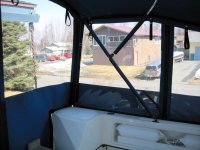caw
New member
- Joined
- Dec 24, 2008
- Messages
- 35
- Reaction score
- 0
- C Dory Year
- 2006
- C Dory Model
- 23 Venture
- Vessel Name
- MY LEE
For those of you with camperbacks, we were wondering what you do with your windows when they aren't needed. We just got a camperback, so need suggestions. Do any of you have straps to roll them up, but still zippered in place at the top? And do any of you roll them up, all together, when they are not on the camperback? Were told to store flat when not in use, but seems an awkward way to handle & transport. Thought it might be handy to be able to roll up in both instances, but don't want to damage the plastic. Your thoughts?
Charlie (caw) & Melle Lee on My Lee
Charlie (caw) & Melle Lee on My Lee

